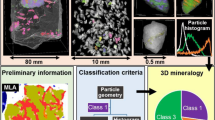Abstract
In general X-ray-computed tomographic (CT) techniques are capable of providing three-dimensional images of the internal structure of opaque materials in a nondestructive manner. The unique cone beam geometry allows acquisition of all two-dimensional projections with only one rotation of the sample, thus providing for fast data acquisition and better X-ray utilization, as a complete two-dimensional detector array receives the cone-shaped flux of rays. Thus, an isotropic three-dimensional volume can be reconstructed without the mechanical translation and the stacking of sequential slices, as is the case for more conventional CT scanners. In this regard, a state-of-the-art, custom designed X-ray microtomography facility to provide very detailed three-dimensional spatial analysis of packed beds of multiphase particles was installed and is in operation at the University of Utah. The reconstructed three-dimensional tomographic volume allows for spatial resolution as small as 5 μm for sample dimensions of up to 40 mm in diameter. Utilization of this custom-designed cone-beam X-ray microtomography facility for the analysis of particulate systems in three dimensions is discussed. Applications described include coal washability analysis for the design and operation of coal-preparation plants, liberation analysis for the evaluation of grinding practice and separation efficiency, mineral exposure analysis for the prediction of the ultimate recovery from heap-leaching operations, three-dimensional particle shape analysis to classify particle populations and, finally, analysis of the pore-structure network of packed particle beds for simulation of flow through such porous structures as encountered infiltration and heap leaching. The initial results from these studies demonstrate the potential utility of detailed three-dimensional microCT information for improved design and operation of mineral processing methods.
Similar content being viewed by others
References
Amenda, N., Choi, S., and Kolloui, R.K., 2001, “The power crust,” Sixth ACM Symposium on Solid Modeling and Applications 2001, paper download at http://www.cs.utexas.edu/users/amenta/powercrust/welcome.html.
Barbery, G., 1991, Mineral Liberation Measurement, Simulation and Practical Use in Mineral Processing, Les Editions GB, Quebec.
Barrett, P.J., 1980, “The shape of rock particles, a critical review,” Sedimentology, Vol. 28, pp. 291–303.
Beddow, J.K., 1981, Particulate Science and Technology, Chemical Publishing Co., New York.
Clark, N.N., Turton, R., and Flemmer, R.L.C., 1989, “The effect of particle shape on fluid-particle interactions,” Particulate Science and Technology, Vol. 7, pp. 399–414.
Dey, T.K., and Giesen, J., 2001, “Detecting undersampling in surface reconstruction,” Proceeding 17th ACM Symposium Computational Geometry, pp. 257–263.
Edelsbrunner, E., and Mucke, E.P., 1994, “Three-dimensional alpha shape,” ACM Trans. Graphics, Vol. 13, pp. 43–72.
Garland, M., and Heckbert, P., 1997, “Surface simplification using quadric error metrics,” SIGGRAPH ’97, pp. 209–216.
Hawkins, A.E., 1993, The Shape of Powder-Particle Outline, John Wiley & Sons Inc., New York.
Hoppe, H., et al., 1992, “Surface reconstruction from unorganized points,” SIGGRAPH ’92, pp. 71–78.
King, R.P., 1994, “Linear stochastic models for mineral liberation,” Powder Technology, Vol. 81, pp. 217–234.
King, R.P., 1999, “Comprehensive Investigation of the Liberation Characteristics of Pyrite and Other Ash-Forming Minerals from Coal,” DOE Final Report, DE-FG22-95PC95220.
King, R.P., and Schneider, C.L., 1993, “An effective SEM-based image analysis for quantitative mineralogy,” KONA, Vol. 11, pp. 165–177.
Leurken, D.W., 1991, Theory and Applications of Morphology Analysis–Fine Particles and Surface, CRC Press, Boca Raton, Florida.
Levoy, M., et al., 2000, “The digital Michelangelo project: 3D scanning of large status,” SIGGRAPH 2000, pp. 131–144.
Lin, C.L., and Miller, J.D., 1996, “Cone beam X-ray microtomography for three-dimensional liberation analysis in the 21st century,” International Journal of Mineral Processing, Vol. 47, pp. 61–73.
Lin, C.L., and Miller, J.D., 2000, “Pore structure and network analysis of filter cake,” The Chemical Engineering Journal, Vol. 80, pp. 221–231.
Lin, C.L., and Miller, J.D., 2001, “A new cone beam X-ray microtomography facility for 3D analysis of multiphase materials,” 2ndWorld Congress on Industrial Process Tomography, Hannover, Germany, 29–31 August, 2001, pp. 98–109.
Lin, C.L., and Miller, J.D., 2002, “The significance of filter cake pore structure as determined by micro-CT in the analysis of filtration phenomena,” Presented at 2002 SME Annual Meeting, February 25–27, 2002, Phoenix, Arizona, Preprint No. 02-112.
Lin, C.L., Miller, J.D., Luttrell, G.H., and Adel, G.T., 2001, “Development of an on-line coal washability analysis system using X-ray computed tomography,” Coal Preparation, Vol. 21, pp. 383–409.
Mandelbrot, B.B., 1977, Fractals: Form, Chance and Dimension, W.H. Free-man, San Francisco.
Maylotte, D.H., Kosky, P.G., Spiro, C.L., Lamby, E.J., and Davis, A., 1985, “Computed Tomography of Coal,” DOE Quarterly Technical Progress Report, No. 5–10, Contract DE-AC21-82MC19210.
Miller, J.D., and Lin, C.L., 1988, “Treatment of polished section data for detailed liberation analysis,” International Journal of Mineral Processing, Vol. 22, pp. 41–58.
Miller, J.D., Lin, C.L., Garcia, C, and Arias, H., 2003, “Ultimate recovery in heap leaching operations as established from mineral exposure analysis by X-ray microtomography,” International Journal of Mineral Processing, Vol. 72, pp. 331–340.
Schneider, C.L., Lin, C.L., King, R.P., and Miller, J.D., 1991, “Improved transformation technique for the prediction of liberation by random fracture model,” Powder Technology, Vol. 67, pp. 103–111.
Spiro, C.L., Holmes, D.S., Lobos, J., and Maylotte, D.H., 1987, “Use of X-ray computed tomography to examine microbial desulfurization of lump coal,” Energy and Fuels, Vol. 1, pp. 76–79.
Ting, J.M, Meachum, L.R., and Rowell, J.D., 1995, “Effect of particle shape on the strength and deformation mechanisms of ellipse-shaped assemblages,” Engineering Computations: Int’l Journal of Computer-Aided Engineering and Software, D.R.J. Owen and K.J. Bathe, eds., Vol. 12(2), pp. 99–108.
Author information
Authors and Affiliations
Rights and permissions
About this article
Cite this article
Miller, J.D., Lin, C.L. Three-dimensional analysis of particulates in mineral processing systems by cone beam X-ray microtomography. Mining, Metallurgy & Exploration 21, 113–124 (2004). https://doi.org/10.1007/BF03403313
Received:
Accepted:
Published:
Issue Date:
DOI: https://doi.org/10.1007/BF03403313



